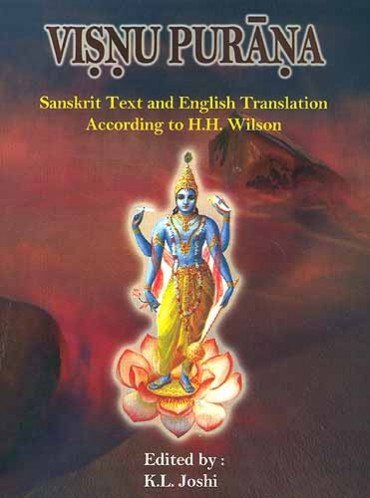The Vishnu Purana
by Horace Hayman Wilson | 1840 | 287,946 words | ISBN-10: 8171102127
The English translation of the Vishnu Purana. This is a primary sacred text of the Vaishnava branch of Hinduism. It is one of the eighteen greater Puranas, a branch of sacred Vedic literature which was first committed to writing during the first millennium of the common era. Like most of the other Puranas, this is a complete narrative from the cr...
1. The Brahmā Purāṇa
1. Brahmā Purāṇa. “That, the whole of which was formerly repeated by Brahmā to Marīci, is called the Brāhma Purāṇa, and contains ten thousand stanzas[1].” In all the lists of the Purāṇas, the Brāhma is placed at the head of the series, and is thence sometimes also entitled the Ādi or ‘first’ Purāṇa. It is also designated as the Saura, as it is in great part appropriated to the worship of Sūrya, ‘the sun.’ There are, however, works bearing these names which belong to the class of Upa-purāṇas, and which are not to be confounded with the Brāhma. It is usually said, as above, to contain ten thousand slokas; but the number actually occurring is between seven and eight thousand. There is a supplementary or concluding section called the Brahmottara Purāṇa, and which is different from a portion of the Skānda called the Brahmottara Khaṇḍa, which contains about three thousand stanzas more; but there is every reason to conclude that this is a distinct and unconnected work.
The immediate narrator of the Brahmā Purāṇa is Lomaharṣaṇa, who communicates it to the Ṛṣis or sages assembled at Naimiṣāraṇya, as it was originally revealed by Brahmā, not to Marīci, as the Matsya affirms, but to Dakṣa, another of the patriarchs: hence its denomination of the Brahmā Purāṇa.
The early chapters of this work give a description of the creation, an account of the Manvantaras, and the history of the solar and lunar dynasties to the time of Kṛṣṇa, in a summary manner, and in words which are common to it and several other Purāṇas: a brief description of the universe succeeds; and then come a number of chapters relating to the holiness of Orissa, with its temples and sacred groves dedicated to the sun, to Śiva, and Jagannāth, the latter especially. These chapters are characteristic of this Purāṇa, and shew its main object to be the promotion of the worship of Kṛṣṇa as Jagannāth[2]. To these particulars succeeds a life of Kṛṣṇa, which is word for word the same as that of the Viṣṇu Purāṇa; and the compilation terminates with a particular detail of the mode in which Yoga, or contemplative devotion, the object of which is still Viṣṇu, is to be performed. There is little in this which corresponds with the definition of a Pañca-lakṣaṇa Purāṇa; and the mention of the temples of Orissa, the date of the original construction of which is recorded[3], shews that it could not have been compiled earlier than the thirteenth or fourteenth century.
The Uttara Khaṇḍa of the Brāhma P. bears still more entirely the character of a Māhātmya, or local legend, being intended to celebrate the sanctity of the Balajā river, conjectured to be the same as the Banās in Marwar. There is no clue to its date, but it is clearly modern, grafting personages and fictions of its own invention on a few hints from older authorities[4].
Footnotes and references:
[1]:

Click to view
[2]:
Col. Vans Kennedy objects to this character of the Brāhma P., and observes that it contains only two short descriptions of pagodas, the one of Konāditya, the other of Jagannāth. In that case, his copy must differ considerably from those I have met with; for in them the description of Puruṣottama Kṣetra, the holy land of Orissa, runs through forty chapters, or one-third of the work. The description, it is true, is interspersed, in the usual rambling strain of the Purāṇas, with a variety of legends, some ancient, some modern; but they are intended to illustrate some local circumstance, and are therefore not incompatible with the main design, the celebration of the glories of Puruṣottama Kṣetra. The specification of the temple of Jagannāth, however, is of itself sufficient, in my opinion, to determine the character and era of the compilation.
[3]:
See Account of Orissa proper, or Cuttack, by A. Stirling, Esq.: Asiatic Res. vol. XV. p. 305.
[4]:
See Analysis of the Brāhma Purāṇa: Journ. Royal As. Soc, vol. V. p. 65.
